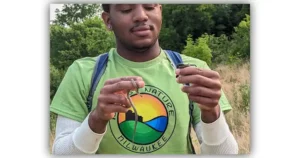You never know what you might find under the snake boards at Hopkins Hollow.
There might be mice or shrews. There might be pill bugs or ants. But if you’re lucky, there will be snakes.
“Basically, we’re checking for common garter snakes, Butler’s garter snakes, and DeKay’s brownsnakes. We’ve mainly found female Butler garter snakes. We haven’t found any common garter snakes, and we’ve found two DeKay’s brownsnakes,” Hassan Richardson reported.
Richardson is in the middle of his summer internship with Nearby Nature, a nonprofit that focuses on environmental justice, stewardship, and outreach in Milwaukee. Richardson, a conservation and environmental science major at UW-Milwaukee, had just finished an urban planning course when he found the internship.
“This (job) was probably one of the few that incorporated environmental justice and ecology and aligned with my most recent career goals,” he said, adding that he’d like to find a career that combines his interests in urban planning, environmental justice, and wildlife biology. He’s a CES major because “it came to me naturally – no pun intended.”
The job is hard – Richardson is outside in the sun for 4-5 hours at a time, doing trash pick-up, volunteering at outreach events, assisting with hikes for community members, and removing invasive plant species from natural areas. The buckthorn is bad, he said, but invasive wild parsley is worse: “If you cut the leaf and the oil gets on your skin and it’s exposed to the sun, it’ll give you burns or a rash in a couple of hours,” Richardson explained.
But for all of the work, there’s plenty of fun. Richardson and his fellow interns have enjoyed field trips to the local Department of Natural Resources office, and they’ve learned a lot about urban natural areas, environmental advocacy, and outreach. They’ve also been able to see some interesting wildlife; Richardson said one of the coolest experiences he had was catching a glimpse of a scissortailed flycatcher, a bird that is rarely seen in Wisconsin.
But the best part is definitely the snakes.
Nearby Nature has been conducting a snake survey this summer, counting the number of several different types of snakes they find and recording the data. They’re working in Hopkins Hollow, a green space near 35th and Hopkins, to find the reptiles. When Richardson finds one under one of the area’s 24 snake boards – large pieces of wood covering the ground that provide excellent cover for snakes and other wildlife – he records its species, length, gender, and whether or not the snake is pregnant.
He’s become good at identifying who is who: Common garter snakes have three scale rows of colors and broader heads while Butler’s garter snakes have four scale rows and narrower heads. Female snakes generally have more tapered tails while male snakes have blunter tails, and he can tell if a female is pregnant by gently pressing above her “vent” – the opening where snakes void their waste and lay eggs – to feel for the presence of eggs.
It’s an important job because Milwaukee needs environmental stewards, especially in communities of color. Many times, environmental justice efforts have ignored the needs of neighborhoods that are primarily non-white. Nearby Nature strives to correct that in Milwaukee by advocating for antiracism and equity among its leadership and constituents, and by stewarding the land so that Hopkins Hollow and nearby Havenwoods – the largest urban state forest in Wisconsin – are available as green spaces for all communities, but especially those that are Black and brown.
“(The DNR) said 60 percent of Wisconsin’s African American population lives within a 5-miles radius of Havenwoods. Not Milwaukee, Wisconsin,” Richardson added.
It wasn’t always like this. Richardson recalls stories from Nearby Nature’s Arts & Youth Leader, Martina Patterson, about the former state of Hopkins Hollow.
“Two years ago, the area that we’re working in was a huge illegal dumping spot. The trash was 12 feet tall, or something like that. People in the community called for help and nobody helped. It took a couple of years for them to get all of the trash picked up,” Richardson said.
Things are changing, thanks to interns like Richardson, the Nearby Nature staff, and the community members who engage with organization. With this summer’s experience, Richardson is more dedicated than ever to environmental justice.
And also to counting snakes.
By Sarah Vickery, College of Letters & Science
